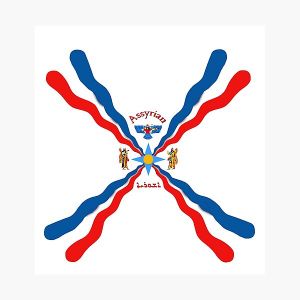Language/Assyrian-neo-aramaic/Grammar/Adjectives
Hi Assyrian Neo-Aramaic learners! 😊
In this lesson, we will dive deeper into Assyrian Neo-Aramaic adjectives. Adjectives are words that describe or modify nouns. They provide more information about the quality, state, appearance, or quantity of the person, place, thing, or idea that the noun represents. In Assyrian Neo-Aramaic, adjectives come after the noun they describe, unlike English, where they come before. For example, in English, we say "a red car," while in Assyrian Neo-Aramaic, we say "car red."
With the completion of this lesson, consider investigating these related pages: How to Use "Be", Plurals & How to Use Have.
Basic Adjectives[edit | edit source]
Let's start with some basic adjectives that you can use in your everyday conversations. These adjectives come after the noun they describe.
| Assyrian Neo-Aramaic | Pronunciation | English |
|---|---|---|
| ܒܝܬܐ (byətə) | be-ya-ta | House |
| ܬܡܘܐ (tmua) | tə-mu-a | Big |
| ܚܰܝܬܳܐ (khayto) | kha-yə-to | Small |
| ܚܙܝܼܩܳܐ (khazyqa) | kha-zi-ya-qa | Dirty |
Here is an example dialogue to see these adjectives in context:
- Person 1: ܒܝܬܐ ܬܡܘܐ (byətə tmua) (Big house)
- Person 2: ܒܝܬܐ ܚܰܝܬܳܐ (byətə khayta) (Small house)
- Person 1: ܒܝܬܐ ܚܙܝܼܩܳܐ (byətə khazyqa) (Dirty house)
Comparison of Adjectives[edit | edit source]
In Assyrian Neo-Aramaic, adjectives can also be compared using comparative and superlative forms.
To form the comparative form of adjectives, we add ܕ (d) before the adjective. For example, if we want to compare two cars and say that one is bigger than the other, we can use the adjective ܬܡܘܐ (tmua), which means "big." We add ܕ (d) and say ܬܡܘܐ ܕܬܡܘܐ (tmua d-tmua), which means "bigger than big." The comparative form always follows the noun.
To form the superlative form of adjectives, we add ܘܠܝ (wala) after the comparative form of the adjective. So, continuing from the previous example, we can say ܬܡܘܐ ܕܬܡܘܐ ܘܠܝ (tmua d-tmua wala), which means "the biggest."
Here's another example to illustrate the comparative and superlative forms of adjectives:
| Assyrian Neo-Aramaic | Pronunciation | English |
|---|---|---|
| ܒܪܝܬܐ (bryta) | be-ri-ta | Cold |
| ܪܘܼܚܬܳܐ (rukhtha) | ru-khə-ta | Hot |
| ܪܚܘܢܬܳܐ (rkhuntə) | rkhun-tə | Soft |
- Person 1: ܒܝܬܐ ܪܘܼܚܬܳܐ ܕܪܚܘܢܬܳܐ (byətə rukhtha d-rkhunta) (Hotter than soft)
- Person 2: ܒܝܬܐ ܪܘܼܚܬܳܐ ܕܪܚܘܢܬܳܐ ܘܠܝ (byətə rukhtha d-rkhunta wala) (The hottest of the softest)
Adjective Agreement[edit | edit source]
In Assyrian Neo-Aramaic, adjectives agree with the gender and number of the nouns they describe. If the noun is singular and masculine, the adjective should be in the singular masculine form. If the noun is singular and feminine, the adjective should be in the singular feminine form. If the noun is plural and masculine, the adjective should be in the plural masculine form. If the noun is plural and feminine, the adjective should be in the plural feminine form.
Here are some examples to illustrate adjective agreement:
| Assyrian Neo-Aramaic | Pronunciation | English |
|---|---|---|
| ܒܝܬܐ ܐܢܬܘܢ (byətə 'ntun) | be-ya-ta an-tun | Your (m) house |
| ܒܝܬܐ ܐܢܬܘܢܝܳܐ (byətə 'ntun-ya) | be-ya-ta an-tun-ya | Your (f) house |
| ܒܝܬܐ ܐܢܬܘܢܘܬܐ (byətə 'ntun-u-tha) | be-ya-ta an-tun-u-tha | Your (pl) house |
- Person 1: ܒܝܬܐ ܐܢܬܘܢ ܬܡܘܐ (byətə 'ntun tmua) (Your (m) big house)
- Person 2: ܒܝܬܐ ܐܢܬܘܢܝܳܐ ܚܰܝܬܳܐ (byətə 'ntun-ya khayto) (Your (f) small house)
- Person 1: ܒܝܬܐ ܐܢܬܘܢܘܬܐ ܚܙܝܼܩܳܐ (byətə 'ntun-u-tha khazyqa) (Your (pl) dirty house)
Conclusion[edit | edit source]
Congratulations! You now have a better understanding of Assyrian Neo-Aramaic adjectives. To improve your Assyrian Neo-Aramaic Grammar, you can also use the Polyglot Club website. Find native speakers and ask them any questions!
➡ If you have any questions, please ask them in the comments section below.
➡ Feel free to edit this wiki page if you think it can be improved. 😎
Great work on completing this lesson! Take a moment to investigate these connected pages: Say Hello and Greetings in Assyrian Neo-Aramaic, Conditional Mood & Pronouns.

